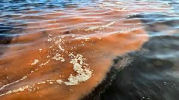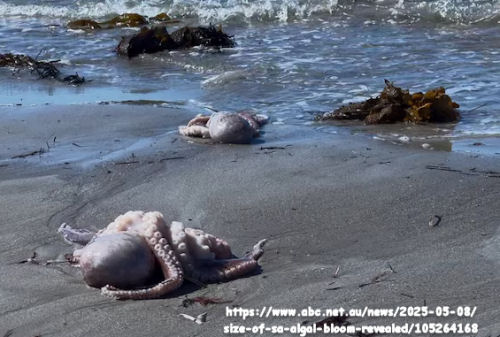 Jeff Dorset’s searing critique below targets the ABC’s mythic framing of Australia’s worst oceanic algal bloom, as seen in Daniel Keane, Leah MacLennan, and Che Chorley’s article, “Australia’s southern coast is in uncharted waters” (ABC, 1 Oct 2025). Far from educating readers on the bloom’s roots—driven by upstream nutrient pollution, degraded ecosystems, and climate-driven heatwaves—the piece casts South Australians as heroic figures battling an inevitable, almost divine force. It sidesteps the severe health risks of swimming amid Karenia mikimotoi’s toxic dinoflagellates, which have killed over 40,000 marine animals and threaten respiratory and skin issues for humans.[1] Dorset’s analysis, paired with a forthcoming piece on the broader environmental and climatic drivers, demands accountability for this preventable catastrophe. (Candobetter Editor.)
Jeff Dorset’s searing critique below targets the ABC’s mythic framing of Australia’s worst oceanic algal bloom, as seen in Daniel Keane, Leah MacLennan, and Che Chorley’s article, “Australia’s southern coast is in uncharted waters” (ABC, 1 Oct 2025). Far from educating readers on the bloom’s roots—driven by upstream nutrient pollution, degraded ecosystems, and climate-driven heatwaves—the piece casts South Australians as heroic figures battling an inevitable, almost divine force. It sidesteps the severe health risks of swimming amid Karenia mikimotoi’s toxic dinoflagellates, which have killed over 40,000 marine animals and threaten respiratory and skin issues for humans.[1] Dorset’s analysis, paired with a forthcoming piece on the broader environmental and climatic drivers, demands accountability for this preventable catastrophe. (Candobetter Editor.)
Criticism of "Australia’s southern coast is in uncharted waters"
I'm disappointed with this over graphic - photo dominated - report on the South Australian algal bloom. It makes no attempt to inform readers of the cause of the bloom - the overpopulation of Australia by 30 years of big business favouring ALP /LNP corporate Goverments, which are destroying Australia's fragile, ancient, unique biodiverse habitats - the oceans, forests - the land - with the biggest population growth invasion, re-colonisation, social engineering of Australia since the First Fleet.
Why doesn't the article explain to readers the upstream Murray Darling enviro-catastrophe created by the agribusiness industries - the foreign owned cotton farms in the north-west of New South Wales taking excessive water from the Darling River? The huge agribusinesses in Victoria and New South Wales where poisonous over-fertilised land is creating polluted rivers which all flow into the Murray Darling system? Do ABC authors have any training in Environmental subjects or basic Australian Geography? Are they not aware of the destructive urban city footprint concept which explains the widespread environmental impact by a city suffering huge population growth? The eco-impact extends into the hinterland, as the population of world's highest consumers/polluters increases? Each migrant arriving in Australia increases his/her eco/carbon footprint by at least 5 times.
Melbourne`s population has been growing at an insane, irresponsible, eco/socially corrupt and destructive 220,000 net since the 1996 Howard Government. As with Sydney, and slightly slower population growth in other capital cities.
This insane population growth creates rapidly increasing demand for food production: agriculture, grazing, building materials - thus the rapid rise of deforestation in hard wood native forests, habitat clearing for swaths of high density housing-estates for rich migrants, huge freshwater demands, and the myriad of environmental costs of infrastructure upgrades, as population sky rockets. And the concomitant increase in agricultural output and its environmental costs - more fertiliser and insecticide application, more irrigation use. That is, theft from the river system to feed more humans ...
Are the authors aware of the Shepparton Mega city proposal by the VIC and federal Governments? This is to rely on massive population expansion, largely fueled by immigrants, to work in the greatly expanded fruit canning industry, and other irresponsible growth addiction high eco-impact projects?
If so why did this report on this shocking algal bloom not include upstream information?
NOTES
[1] Note that the ABC did publish an article that included some marine science and warned of the danger to humans here: https://www.abc.net.au/news/2025-05-08/size-of-sa-algal-bloom-revealed/105264168

Comments
Sheila Newman
Wed, 2025-10-01 22:34
Permalink
Perfect Storm: Unraveling SA’s Epic Algal Bloom
In addition to the upstream nutrient pollution from population-driven agricultural intensification in the Murray-Darling Basin, as highlighted by the writer, a perfect storm of factors fueled the 2025 South Australian algal bloom. Human activity has degraded ecosystems, with 80–90% losses of kelp forests, seagrass beds, and shellfish reefs reducing natural filtration and amplifying nutrient impacts, as noted by the Biodiversity Council. Industrial runoff from Adelaide and ash from past bushfires (e.g., 2020) have further overcharged coastal waters with nutrients, per SA EPA reports. Compounding these, a marine heatwave (2.5–3°C above average since September 2024) created ideal conditions for Karenia mikimotoi, likely driven by long-term climate change, though natural climate cycles like upwelling in 2023–24 contributed deep-sea nutrients. Prolonged calm seas also minimized mixing, concentrating algae at the surface. Enhanced monitoring via satellites and citizen science, logging 12,000+ observations, may heighten perceptions of the bloom’s scale. These factors, drawn from PIRSA and SA EPA data, complement the writer’s focus on upstream agricultural pressures, revealing a complex interplay of human-induced and environmental drivers.
This is a tragedy whose proportions we can only suspect. Australia is in deep shit.
Add comment